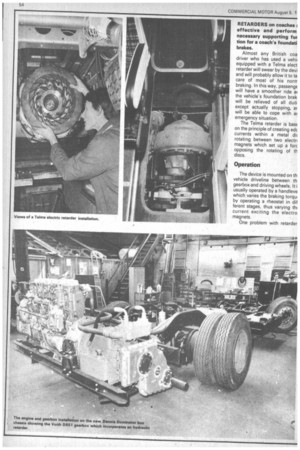Coach drivers swear by it
Page 57

Page 56

If you've noticed an error in this article please click here to report it so we can fix it.
RETARDERS on coaches effective and perform necessary supporting fur tion for a coach's foundati brakes.
Almost any British coa driver who has used a vehii equipped with a Telma elect retarder will swear by the devi and will probably allow it to ta care of most of his norrr braking. In this way, passenge will have a smoother ride al the vehicle's foundation brak will be relieved of all duti except actually stopping, at will be able to cope with ar emergency situation.
The Telma retarder is bast on the principle of creating edc currents within a metal di! rotating between two electri magnets which set up a fort opposing the rotating of th discs.
Operation
The device is mounted on th vehicle driveline between th gearbox and driving wheels. It i usually operated by a handleve which varies the braking torqul by operating a rheostat in dil ferent stages, thus varying thi current exciting the electro magnets.
One problem with retarder that they work only on the ck wheels and under certain, cumstances, for example, ile cornering on a damp road hen the rear of the vehicle uld break away.
A Telma foot control is now ing developed to connect the vice to the vehicle foot brake dal. With this, the Telma ould be operated by initial essure on the brake pedal aving the foundation brakes cope with heavy braking uations.
Telma retarder installations Britain are expensive — it osts about £1,100 to fit a
-elma to a British heavyweight :oach — and installations are
tot totally without lisadvantage.
I spoke to Sam Debman, :hief engineer at Grey-Green :oaches of London, about his )xperience of Telma retarders. 3rey-Green's fleet consists
-nainly of a mixture of Bedford 3n d Leyland Leopard coaches. Vlost of the semi-automatic _eopards are equipped with Telmas.
We compared brake life of a Grey-Green Leopard with a Telma retarder and one without. Both Leopards were hard working vehicles in daily use. The rear brakes on the Telma-equipped Leopard needed relining approximately every 65,000 miles while the rear brakes of the other coach required linings after 25,000 miles. Given that a heavyweight coach should remain in service for at least 10 years and a brake reline costs about £65, the retarder would prove cost effective.
Excessive wear
Unfortunately, Mr. Debman has found that Leopards fitted with an electric retarder tend to suffer from excessive crown wheel and pinion wear which could result in a £500 repair bill every two years.
The problem stems from the fact that British vehicles are not designed to be fitted with electric retarders and their fitting is not offered as an option by manufacturers. The fitment, therefore, tends to have the status of a bolt-on goodie.
I feel, after driving Telmaequipped coaches, that the advantages of the device outweigh its disadvantages, an opinion reflected in the fact that 6,000 coaches up and down the country are equipped with it. Another popular retarding device used in British coaches is the exhaust brake. This increases engine braking power by restricting the exhaust flow and causing development of high pressure in the exhaust manifold sufficient to blow open the exhaust valve during each induction stroke, subsequently supercharging the compression stroke of the engine.
The device has to be carefully controlled and adjusted to avoid damaging the engine.
The advantage
The advantage of the exhaust brake retarder installation over the electric retarder is its costs. The installation of a Retro exhaust brake costs about £200 per coach.
The main disadvantage is that the efficiency of the device is related to the engine speed. If a driver loses a gear, he will lose his retardation effect.
Developments are also taking place with retarders that operate hydraulically by transferring kinetic energy from braking into heat in hydraulc fluid. The heat then has to be dissipated through the vehicle cooling system and an oil cooler.
Hydraulic retarders are proving successful in city bus operations, although as yet, I do not know of any hydraulic retarders fitted in coaches in Britain,








































































































